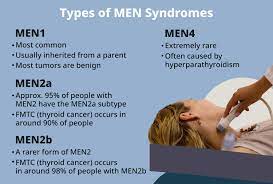 A group of disorders characterized by the presence of medullary carcinoma of the thyroid.
A group of disorders characterized by the presence of medullary carcinoma of the thyroid.
Three subtypes 2A, 2B and familial medullary thyroid cancer (FMTC).
MTC is the dominant component of the multiple endocrine neoplasia (MEN) type 2 syndromes, MEN2A and MEN2B.
MEN2A accounts for 95% of the cases.
The following four variants of MEN2A have been recognized:
Classical MEN2A – The most common variant.
MTC is uniformly present; pheochromocytoma, primary hyperparathyroidism, or both occur less frequently.
MEN2A with cutaneous lichen amyloidosis (CLA) – CLA or typical neurologic pruritus may present in infancy, before the onset of clinically evident MTC
MEN2A with Hirschsprung disease
Familial medullary thyroid carcinoma (FMTC) – MTC only, in the absence of a family history of pheochromocytoma or hyperparathyroidism
Mutations in RET, a transmembrane proto-oncogene located on chromosome 10q11.2, are responsible for MEN2.
MEN type 2A is associated with tumors of the thyroid, parathyroid, and adrenal medulla.
The prevalence of MEN type 2 (both A and B) is approximately 1 in 35,000 persons.
MEN2A and familial medullary carcinoma of the thyroid typical present in the 3rd decade of life.
MEN2A is the most common of MEN2 disorder and includes MTC, pheochromocytoma, and primary hyperparathyroidism.
MTC is the predominant disorder, greater than 95%, in MEN2A and accounts for 75% of the hereditary MTC.
MEN2A Is characterized by multifocal and bilateral disease presenting in early adulthood.
MEN2A mortality associated with MTC and early recognition and intervention are necessary so process can be cured orprevented by early thyroidectomy screening at risk family members.
MEN2A associated with pheochromocytomas and up to 50% of cases.
MEN2 related pheochromocytomas are usually benign and multicentric, preceded by adrenal medullary hyperplasia and predominately secreting both epinephrine/metanephrine and norepinephrine/nor metanephrine.
MEN2A associated with hyperparathyroidism in up to 20-35% of patients.
MEN2B associated MCT presents in individuals younger than 20 years.
MEN type 2B ois also associated with thyroid and adrenal medulla tumors, but is found in patients with marfanoid features.
MEN2B effects 8-15% of all MEN2 patients.
MEN2B has a hereditary predisposition to MTC and pheochromocytoma, but not to hyperparathyroidism.
MEN2B patients have mucosal neuromas of the lips tongue and intestinal ganglioneuromas.
MEN2B patients also have disorders such as chronic constipation and megacolon, abnormalities in the upper to lower body ratio, skeletal deformities such as kyphoscoliosis, lordosis, joint laxity, Marfanoid habitus, everted eyelids and myelinated corneal nerves (O’Riordain DS et al).
MEN2B patients develop medullary carcinoma of the thyroid and a very early age with a very aggressive course.
100% of patients with MEN2B develop medullary carcinoma of the thyroid at a young age, so the diagnosis is delayed and these patients are seldom cured.
Prompt diagnosis of MEN2B syndrome is crucial as it is associated with almost 100% and 50% lifetime risk of early-onset medullary thyroid carcinoma and pheochromocytomas, respectively.
Prophylactic curative thyroidectomy is required in the neonatal period in the patients identified by genetic screening.
